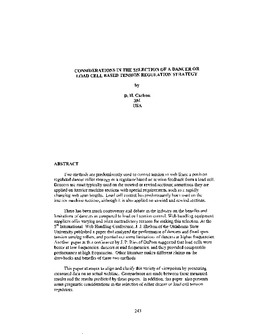| dc.contributor.author | Carlson, D. H. | |
| dc.contributor.other | International Conference on Web Handling (2001) | |
| dc.date.accessioned | 2019-11-08T18:59:19Z | |
| dc.date.available | 2019-11-08T18:59:19Z | |
| dc.date.issued | 2001-06 | |
| dc.identifier | oksd_icwh_2001_carlson | |
| dc.identifier.citation | Carlson, D. H. (2001, June). Considerations in the selection of a dancer or load cell based tension regulation strategy. Paper presented at the Sixth International Conference on Web Handling (IWEB), Stillwater, OK. | |
| dc.identifier.uri | https://hdl.handle.net/11244/321838 | |
| dc.description.abstract | Two methods are predominantly used to control tension in web lines: a position regulated dancer roller strategy or a regulator based on tension feedback from a load cell. Dancers are most typically used on the unwind or rewind sections; sometimes they are applied on interior machine sections with special requirements, such as a rapidly changing web span lengths. Load cell control has predominantly been used on the interior machine sections, although it is also applied on unwind and rewind sections. | |
| dc.description.abstract | There has been much controversy and debate in the industry on the benefits and limitations of dancers as compared to load cell tension control. Web handling equipment suppliers offer varying and often contradictory reasons for making this selection. At the 5th International Web Handling Conference, J. J. Shelton of the Oklahoma State University published a paper that analyzed the performance of dancers and fixed span tension sensing rollers, and pointed out some limitations of dancers at higher frequencies. Another paper at this conference by J.P. Ries of DuPont suggested that load cells were better at low frequencies, dancers at mid frequencies, and they provided comparable performance at high frequencies. Other literature makes different claims on the drawbacks and benefits of these two methods. | |
| dc.description.abstract | This paper attempts to align and clarify this variety of viewpoints by presenting measured data on an actual webline. Comparisons are made between these measured results and the results predicted by these papers. In addition, this paper also presents some pragmatic considerations in the selection of either dancer or load cell tension regulators. | |
| dc.format | application/pdf | |
| dc.language | en_US | |
| dc.publisher | Oklahoma State University | |
| dc.rights | In the Oklahoma State University Library's institutional repository this paper is made available through the open access principles and the terms of agreement/consent between the author(s) and the publisher. The permission policy on the use, reproduction or distribution of the article falls under fair use for educational, scholarship, and research purposes. Contact Digital Resources and Discovery Services at lib-dls@okstate.edu or 405-744-9161 for further information. | |
| dc.title | Considerations in the selection of a dancer or load cell based tension regulation strategy | |
| osu.filename | oksd_icwh_2001_carlson.pdf | |
| dc.type.genre | Conference proceedings | |
| dc.type.material | Text | |
